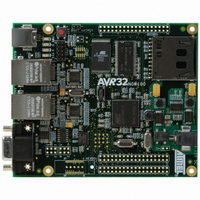ATNGW100 Atmel, ATNGW100 Datasheet - Page 4

ATNGW100
Manufacturer Part Number
ATNGW100
Description
KIT AVR32 NETWORK GATEWAY
Manufacturer
Atmel
Series
AVR®32r
Type
MCUr
Specifications of ATNGW100
Contents
Board and Linux Dev. and Debug Toolchain
Processor To Be Evaluated
AT32AP7000
Data Bus Width
32 bit
Interface Type
RS-232, Ethernet, USB
Silicon Manufacturer
Atmel
Core Architecture
AVR
Core Sub-architecture
AVR UC3
Silicon Core Number
AT32AP7000
Silicon Family Name
AVR
Kit Contents
Board CD Docs
Rohs Compliant
Yes
For Use With/related Products
AT32AP7000, AT32AP7001, AT32AP7002
Lead Free Status / RoHS Status
Lead free / RoHS Compliant
Available stocks
Company
Part Number
Manufacturer
Quantity
Price
Company:
Part Number:
ATNGW100
Manufacturer:
Atmel
Quantity:
135
4 Results
Table 3-1. Iperf measurement results
5 Further improvements
6 References
Board
ATSTK1000
ATNGW100
4
AVR32705
Kernel
2.6.23-rc7
2.6.23-rc6
+ RX offset
+ noncoherent RX
+ avoid RX copy
+ RX offset
+ noncoherent RX
+ avoid RX copy
put_page
on and it is no longer used as a DMA buffer, the reference count drops to zero and
the page is freed.
The iperf measurement results are shown in Table 3-1. The measurements were
obtained as follows.
•
•
•
•
In the end, the three optimizations combined result in a 21% bandwidth increase on
the STK1000 and a 16.3% bandwidth increase on the NGW100.
Some of the results were a bit surprising. Since the NGW100 has lower memory
bandwidth than the STK1000 (16- vs 32-bit SDRAM databus), it is very strange that it
apparently had less benefit from avoiding the copy operation. Also, the TCP TX
bandwidth became lower on both the STK
RX copy” patch was applied.
Unless this is pure noise, it seems to indicate that the new driver handles certain
corner cases less than optimally, and there might be more room for improvement in
the driver.
Information about AT32AP7 is available on
1. Iperf website:
2. How SKBs work:
TCP RX bandwidth: “iperf –s” on the target and “iperf –c 192.168.1.231” on the
host.
TCP TX bandwidth: “iperf –s” on the host and “iperf –c 192.168.1.21” on the
target.
UDP RX datagram loss: “iperf –s –u” on the target and “iperf –c 192.168.1.231 –u
–b 60000000” on the host.
UDP TX datagram loss: “iperf –s –u” on the host and “iperf –c 192.168.1.21 –u –b
60000000” on the target.
(). Eventually, when a page has been freed from all the fragment lists it was
54.6
54.5
58.8
66.1
43.6
43.6
47.6
50.7
RX
TCP Bandwidth (Mbit/s)
http://dast.nlanr.net/Projects/Iperf/
http://vger.kernel.org/~davem/skb.html
69.1
71.3
70.3
65.5
56.3
55.3
55.7
50.9
TX
®
http://www.atmel.com/avr32/
1000 and the NGW100 when the “avoid
UDP Datagram Loss @ 60 Mbps
0.039%
14%
17%
44%
50%
46%
19%
0%
RX
32066A-AVR32-02/08
0%
0%
0%
0%
0%
0%
0%
0%
TX







